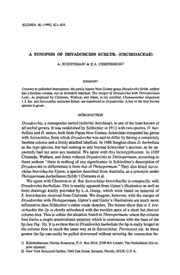
A synopsis of Dryadorchis Schltr. (Orchidaceae) PDF
Preview A synopsis of Dryadorchis Schltr. (Orchidaceae)
BLUMEA 40 (1995) 421-424 A synopsis of Dryadorchis Schltr. (Orchidaceae) A. Schuiteman & E.A.Christenson Summary Contrarytopublisheddescriptions, thepoorlyknownNew Guinea genusDryadorchisSchltr.neither has afootless column,noran immobile labellum. The mergerofDryadorchis with Thrixspermum Lour., asproposed by Clements, Wallace, andJones, is not justified. Chamaeanthus singularis J.J.Sm. andSarcochilus huliorum Schuit. aretransferredtoDryadorchis. Akey tothe fourknown species isgiven. Introduction Dryadorchis, a monopodial orchid(subtribe Aeridinae), is oneoftheleastknownof allorchid genera.Itwas establishedby Schlechterin 1913withtwo species, D.bar- bellataandD.minor,both fromPapua New Guinea.Schlechtercompared his genus withSarcochilus, fromwhich Dryadorchis was saidto differby having acompletely footlesscolumnandafirmlyattachedlabellum.In 1988Senghas choseD. barbellata as thetype species, buthad nothing to addbeyond Schlechter'saccount, as he ap- parently had not seenany material. Weagree with this lectotypification. In 1989 Clements, Wallace, and Jones reducedDryadorchis to Thrixspermum; according to theseauthors "there is nothing ofany significance in Schlechter's description of Dryadorchis to differentiateitfromthatof Thrixspermum. THEY ALSO LISTED Sarco- chilusbrevirhachisUpton, aspecies describedfromAustralia, as asynonymunder Thrixspermum barbellatum(Schltr.) Clementsetal. Weagreewith Clementsetal. thatSarcochilus brevirhachisis conspecific with Dryadorchis barbellata.Thisisreadily apparentfromUpton's illustrationas well as fromdrawings kindly provided by L.A.Garay, which were basedon materialof S. brevirhachisreceivedfromClements.We disagree, however, with themergerof Dryadorchis with Thrixspermum. Upton's and Garay's illustrationsare much more informativethanSchlechter'srathercrudesketches. Theformershow thatinS. bre- virhachisthe lip is clearly articulatedwith the swollenapex ofashort but distinct columnfoot.This is unlikethesituationfoundin Thrixspermum, wherethecolumn footforms a singleunarticulatedstmcture whichis continuouswith thebaseofthe lip(see Fig. 1b).ItisevidentthatinDryadorchis barbellatathelipisreally hinged to the columnfoot in muchthe sameway as in Sarcochilus, Pterocerasetc. In these generathe lip can easily bepulled downwardwithoutsevering theconnectionbe- 1) Rijksherbarium/Hortus Botanicus, P.O.Box 9514,2300 RALeiden,The Netherlands (forre- print requests). 2) New York BotanicalGarden, 1646OakStreet,Sarasota,Florida,34236,U.S.A. 422 BLUMEA Vol. 40, No. 2, 1995 tween lipand columnfoot.In Thrixspermum, ontheotherhand,thesameactionwill usually breakoffthelip.Moreover, in Thrixspermum thereis always a callusin the centre oftheconcave baseofthelip;thisislacking inDryadorchis. When describing Sarcochilus huliorum, one ofus(A.S.) pointed outthat this species was an aberrantmemberofSarcochilus, apparently relatedtoS.singularis, andthatthese two species might makeupa genusoftheirown. Also discussedwere thedifferencesbetweenSarcochilus, Brachypeza, andPteroceras.Being misledby Schlechter'serroneous description ofDryadorchis andthereductionofDryadorchis to Thrixspermum by Clements etal., Dryadorchis was not includedin the discus- sion. From the aboveit is quite clear, however, thatSarcochilus huliorumandS. singularis arecongeneric withDryadorchis. Thenecessary combinationsare made below. Therelationships ofDryadorchis within thesubtribe Aeridinaearedifficulttoas- sess. Withoutthebacking ofathorough cladisticanalysis statementsaboutaffinities are largely guesswork. We donot know, forexample, whetherthecharacterstates 'flowers ephemeral' and 'liparticulatedwith thecolumnfoot' are apomorphic or plesiomophic in theclade inwhichDryadorchis belongs. Weare convinced, how- ever,thatasubdivison ofthesubtribe basedon thestructure ofthepollinia alone,as frequently practised in recentliterature,oftenbrings togetherdiscordantelementsand separatesgenerawhichmay wellbeclosely related. DRYADORCHIS Dryadorchis Schltr., FeddeRep.,Beih. 1 (1913)976;Senghasin Schltr.,Die Orch.,Ed. 3 (1988) 1201;Clements,Wallace & Jones,Austral. Orch. Res. 1 (1989) 144 (insyn. sub Thrixsper- mum). —Lectotype: D. barbellata Schltr. (chosenby Senghas, I.e.). Almost stemlessepiphytes. Leaves subfalcate, twistedatthebaseandmore orless spreading inoneplane. Inflorescencearaceme, solitary; peduncle elongated, patent; rachis swollen, angular, pointing downward.Flowersephemeral, appearing succes- sively, singly or in pairs. Columnstout;foot relatively short, swollen, pubescent. Lip hinged to the columnfoot, with shallow concavities, not spurred. Pollinia4, subequal, in 2 globose masses (NB: D. minoris in several respects incompletely known). Distribution—NewGuinea(inch SchoutenArchipelago), probably endemic(see note underD. barbellatabelow). Sealevel upto 1700m. KEY TO THE SPECIES 1a. Upper surfaceofthelip withamedianpair oflateralkeels . 4. D.singularis b. Uppersurfaceofthelip unadornedatthe median, smooth 2 2a. Lip withatransverse crestbetweenthelaterallobes 1. D.barbellata b. Lip withoutatransversecrestbetweenthelaterallobes 3 3a. Sepals more than 10 mmlong 2. D. huliorum b. Sepals less than5 mmlong 3.D. minor A. Schuiteman & E.A. Christenson: Synopsis ofDryadorchis 423 Fig. 1.Cross sectionsthroughcolumn andlip of:a.Dryadorchis huliorum (Schuit.)Christenson & Schuit.;b. Thrixspermumpurpurascens (Blume)Rchb.f.(DrawnbyA.Schuiteman;a: afterLeiden cult. 31682;b: afterLeiden cult.25253). 1. Dryadorchis barbellataSchltr. — Fig. 2a, b Dryadorchis barbellata Schltr.,FeddeRep., Beih. 1(1913)976;ibid. 21 (1928)t. 344 f. 1325;Sen- Sghasin Schltr.,DCie Orch., Ed. 3H(1988) 1201,f. 1L025.— ThrixTspermum barbRellatum .......................119891Schle4chte4r 18.550 (Bf), 19052(B t),PapuaNew Guinea,MadangProv., 1300 m. Sarcochilus brevirhachisUpton,Orchadian 5(1976)24, fig. — Type:Karnaghan3(NSW,n.v.), Australia,North Queensland,1200m. Note—According toClementsetal. thereis considerableconfusionas tothetype locality ofSarcochilusbrevirhachis. Although nosuch confusionisapparentfrom Upton's article,weagreethatitis unlikelythataspecies previously knownonly from theMadang ProvinceofPapua New Guineashouldoccur inQueensland, Australia. 2.Dryadorchis huliorum(Schuit.) Christenson&Schuit., comb.nov. —Fig. 1a, 2c, d Sarcochilus huliorum Schuit.,Blumea 38(1994)513,f.1.— Type:Leidencult. 31682 (leg. Schui- teman, Mulder& Vogel90-375)(L holo;K, LAE iso;spirit mat.),PapuaNew Guinea,South- ern HighlandsProv., 1700 m. Note— Mr.P. OrmerodandMr. J.J.Woodboth andindependently drewour at- tOenFtionWtoHanIeCaHrliercToHlleEctYionoAfDL.ShuOlioruGmE, NEROUSLY PROVIDED Reeve 624, Papua New Guinea, SouthernHighlands Prov., LakeKopia- go, 1300m (AMES, CBG, E, K, L [?], LAE). TheLeiden duplicate appears to be missing, henceour oversight. 3. Dryadorchis minorSchltr. — Fig. 2e Dryadorchis minor Schltr.,FeddeRep.,Beih. 1(1913)977;ibid. 21(1928)t.344 f. 1326.—Type: Schlechter 16914(B t,PapuaNew Guinea,MadangProv., 1000 m. 424 BLUMEA Vol. 40, No. 2, 1995 Fig. 2.Labelli ofDryadorchis. a,b.D. barbellata Schltr.;c, d. D. huliorum (Schuit.) Christenson & Schuit.;e. D. minor Schltr.;f,g.D. singularis(J.J. Sm.)Christenson & Schuit. —Scalebar = 3mm(Drawnby A.Schuiteman;a, b:redrawn afteranunpublishedsketchbyGaraybased onma- terialreceived from Clements;c, d:afterLeiden cult. 31682;e:redrawn afterSchlechter [1928];f,g: redrawn afterJ.J.Smith[1915]). 4. Dryadorchis singularis (J.J. Sm.) Christenson & Schuit., comb. nov. — Fig. 2f, g Chamaeanthus singularis J.J.Sm.,Bull. Jard. Bot.BuitenzorgII, 3(1912)77. -—Sarcochilus sin- gularis(J.J.Sm.) J.J.Sm.,Fedde Rep. 12(1913)27;Nova Guinea 12(1915)457,t. 178f.331; ibid. 14(1929)493. —Type: Gjellerup451 (BO, n.v.),Irian Jaya,northeastern part,50 m. Note— Alsofound on theislandofBiak(Schouten Archipelago), atsealevel.
